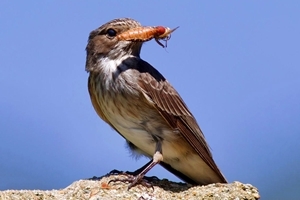Spotted flycatcher
 The sun was shining (which was a first recently in the last few weeks this August!) and I was out doing a butterfly transect within the Martin Down Farmer Cluster, and as I am newly appointed, I am having the pleasure of discovering corners of the countryside that I haven’t been to before and becoming familiar with my “patch” while conducting surveys. I was up on Pentridge Down SSSI, a prehistoric hillfort, looking out across breathtaking views of Dorset, Hampshire and Wiltshire and as far as the Isle of Wight to the south, watching the plumes of dust rising from combines out in force below frantically trying to get the crops in after such an awful start to harvest.
The sun was shining (which was a first recently in the last few weeks this August!) and I was out doing a butterfly transect within the Martin Down Farmer Cluster, and as I am newly appointed, I am having the pleasure of discovering corners of the countryside that I haven’t been to before and becoming familiar with my “patch” while conducting surveys. I was up on Pentridge Down SSSI, a prehistoric hillfort, looking out across breathtaking views of Dorset, Hampshire and Wiltshire and as far as the Isle of Wight to the south, watching the plumes of dust rising from combines out in force below frantically trying to get the crops in after such an awful start to harvest.
I have been told that this hill is an ideal place to be to see migrants coming and going, and as I looked up, I noticed five spotted flycatchers (Muscicapa striata), a migrant species that I haven’t seen for years, perched up in a gnarly old crab apple tree. At a first glance, spotted flycatchers may look at bit drab, dull, brownish-grey birds, or as my degree lecturer Andy used to say LBJs – Little Brown Jobbies. And not to be too rude, they do look a bit boring. But don’t be fooled, these birds beautiful in a modest way. I watched them for a time flitting between the branches and dashing and swooping out of the tree, grabbing insects (and the butterflies I was trying to record!) on the wing in such a fantastic aerobatic display, then returning to their same perch to consume what they had caught. They may be dowdy-looking, but their flying skills really do make up for it!
Spotted flycatchers are one of the later spring migrants, arriving in the UK from Africa in late April or early May and then leaving around August to September. They don’t waste any time rearing a family and tend to nest in the same niche – a hole in the wall, a shaded ledge, or a fork of ivy, and in some cases the same nest is repaired and reused again and again. The first brood has usually flown before the end of June, and in warm summers a second brood has been produced by early August. The most common way of noticing these modest birds is from their swooping flight in pursuit of flying insects, including not only small flies, but also moths, butterflies and on occasions dragonflies. However, if the weather is not on their side, like it has been recently, they switch to ground feeding, which is not as successful, and can suffer in prolonged bad weather conditions.
It’s mind-blowing really that these tiny birds, weighing only 17g with a wingspan of 24cm, fly all the way from tropical Africa to the UK and may only be here for a couple of months – just long enough to rear their young, feed up and then set out to fly all the way back to Africa! So, if you see a LBJ flitting about in the next couple of weeks, it might be a spotted flycatcher feeding up before its long flight back to sunnier climes. And remember, bright isn’t always beautiful!
Megan Lock
Advisory
Photo credit: c.a.h.w.